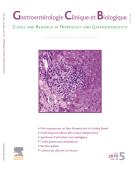HEPACOM: multicenter, observational prospective study of outcome and monitoring of HCV positive antiviral-naïve patients managed in the French health care system - 29/03/08
Hélène Agostini [1 et 2],
Laurent Castera [3],
Pascal Melin [4],
Laurent Cattan [5],
Françoise Roudot-Thoraval [6]
Mostrare le affiliazioniHEPACOM: étude observationnelle multicentrique prospective du devenir et du suivi des malades VHC positifs naïfs de tout traitement antiviral dans le système de soins français |
Objectif |
Étudier le devenir et le suivi des malades porteurs du virus de l'hépatite C (VHC) naïfs de tout traitement antiviral dans le système de soins.
Méthodes et malades |
Deux groupes de médecins généralistes (MG), groupe I (spécialisés en addictologie) et groupe II (autres médecins généralistes) ont recruté des malades VHC positifs, non traités et les ont suivis durant 12 mois.
Résultats |
Parmi 4 660 malades recrutés, 2 038 malades recrutés par 462 MG du groupe I et 1 756 malades recrutés par 588 MG du groupe II ont été analysés. Il s'agissait d'adultes de 42 ans ± 14 ans. Le sex-ratio hommes/femmes était de 1,7. Dix pour cent étaient coïnfectés par le VIH, 12 % étaient consommateurs excessifs d'alcool, 61 % usagers actuels de drogues, dont 75 % (soit 45 % de la population totale) recevaient un traitement substitutif. Des lésions hépatiques minimes (stade ≪ A2 et ≪ F2 en score METAVIR) étaient observées chez 12 % de la population totale; une cirrhose dans 13 % des cas de fibroses significatives (≥ F2). En fin de suivi, 64 % des malades avaient vu un spécialiste. Un traitement antiviral était initié chez 20 %, soit 32 % des malades ayant consulté un spécialiste. L'activité professionnelle (P ≪ 0,0001), le jeune âge (P=0,007), un diagnostic plus récent (P≪0,0001), l'absence de co-infection VIH (P = 0,015), le sexe masculin (P = 0,006), l'absence de traitement substitutif (P = 0,006), une histologie hépatique antérieure avec score METAVIR A et F ≥ 2 (≪ 0,0001) et un suivi par un MG du groupe I (P ≪ 0,007) étaient les facteurs prédictifs indépendants de l'initiation du traitement antiviral.
Conclusion |
Seulement un tiers des malades ayant accédé au système de soins a débuté un traitement antiviral, et certaines catégories (les femmes, les malades coïnfectés par le VIH, les usagers de drogues substitués) plus difficilement que d'autres. Les recommandations de la Conférence de consensus de 2002, intervenant au milieu de l'étude, n'ont probablement été suivies que par une minorité de médecins.
Objective |
To study management practices in the French health care system for antiviral-naïve patients with chronic hepatitis C virus (HCV) infection.
Methods and patients |
Two groups of general practitioners, group I (special training and experience in drug addiction) and group II (other general practitioners) enrolled untreated HCV positive patients and noted management practices for a 12-month period.
Results |
Amoung 4660 enrolled patients, 2038 enrolled by 462 general practitioners in group I and 1756 enrolled by 588 general practitioners in group II were retained for analysis. These patients were adults, aged 42±14 years, who were naïve to antiviral treatment. The male/female ratio was 1: 7. Ten percent were coinfected with HIV, 12% had excessive alcohol intake, and 61% were current drug users, 75% of whom (45% of the total population) were taking replacement therapy. Minimal hepatic lesions (stage ≪A2 and F2 in METAVIR scoring) were observed in 12% of the total population; cirrhosis in 13% of patients with significant fibrosis (≥F2). At the end of the monitoring period, 64% of the patients had been referred to a specialist. Antiviral treatment had been started in 20%, i.e. 32% of the patients who consulted a specialist. Occupational activity (P≪0.0001), young age (P=0.007), more recent diagnosis (P≪0.0001), lack of HIV co-infection (P=0.015), male gender (P=0.006), lack of replacement treatment (P=0.006), previous liver histology with METAVIR A and F≥2 (P≪0.0001) and enrolment by a group I general practitioner (P≪0.007) were the independent predictive factors of initiation of antiviral treatment.
Conclusion |
Only one-third of patients with access to the French health care system started antiviral treatment and some categories of patients, including women, patients co-infected with HIV and patients on replacement therapy, were less likely to be treated than others. The recommendations of the French Consensus Conference, held in the middle of the study period (2002), might have been implemented (probably followed) by a minority of general practitioners.
Mappa
© 2007 Elsevier Masson SAS. Tous droits réservés.
Vol 31 - N° 12
P. 1074-1080 - Dicembre 2007 Ritorno al numeroBenvenuto su EM|consulte, il riferimento dei professionisti della salute.

